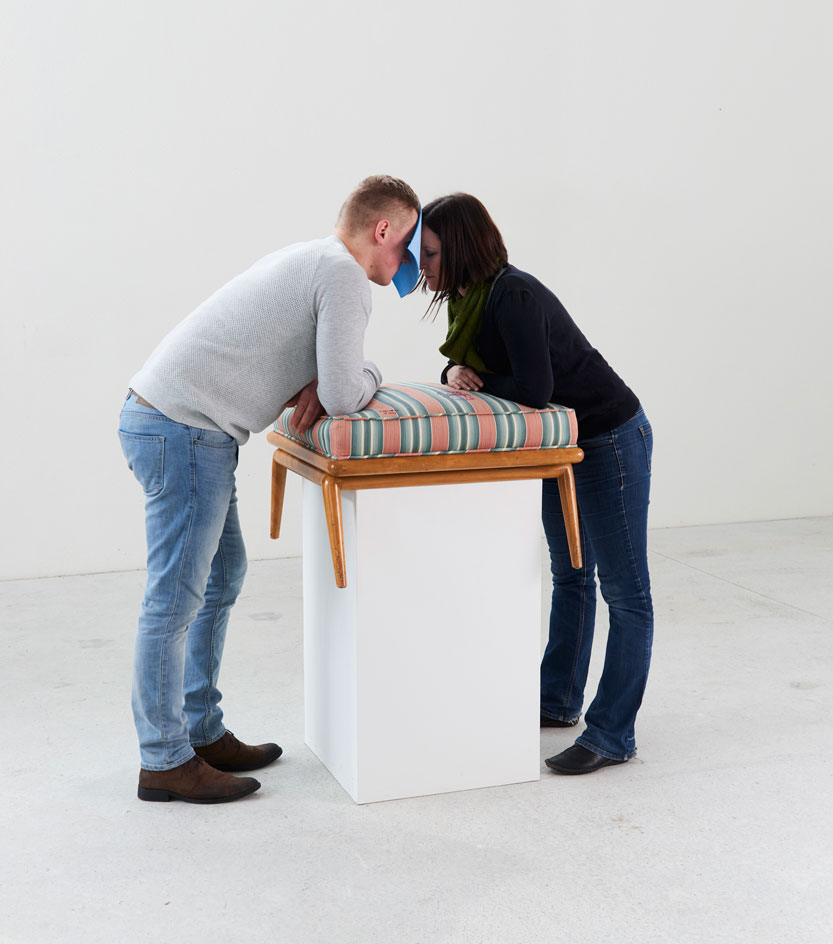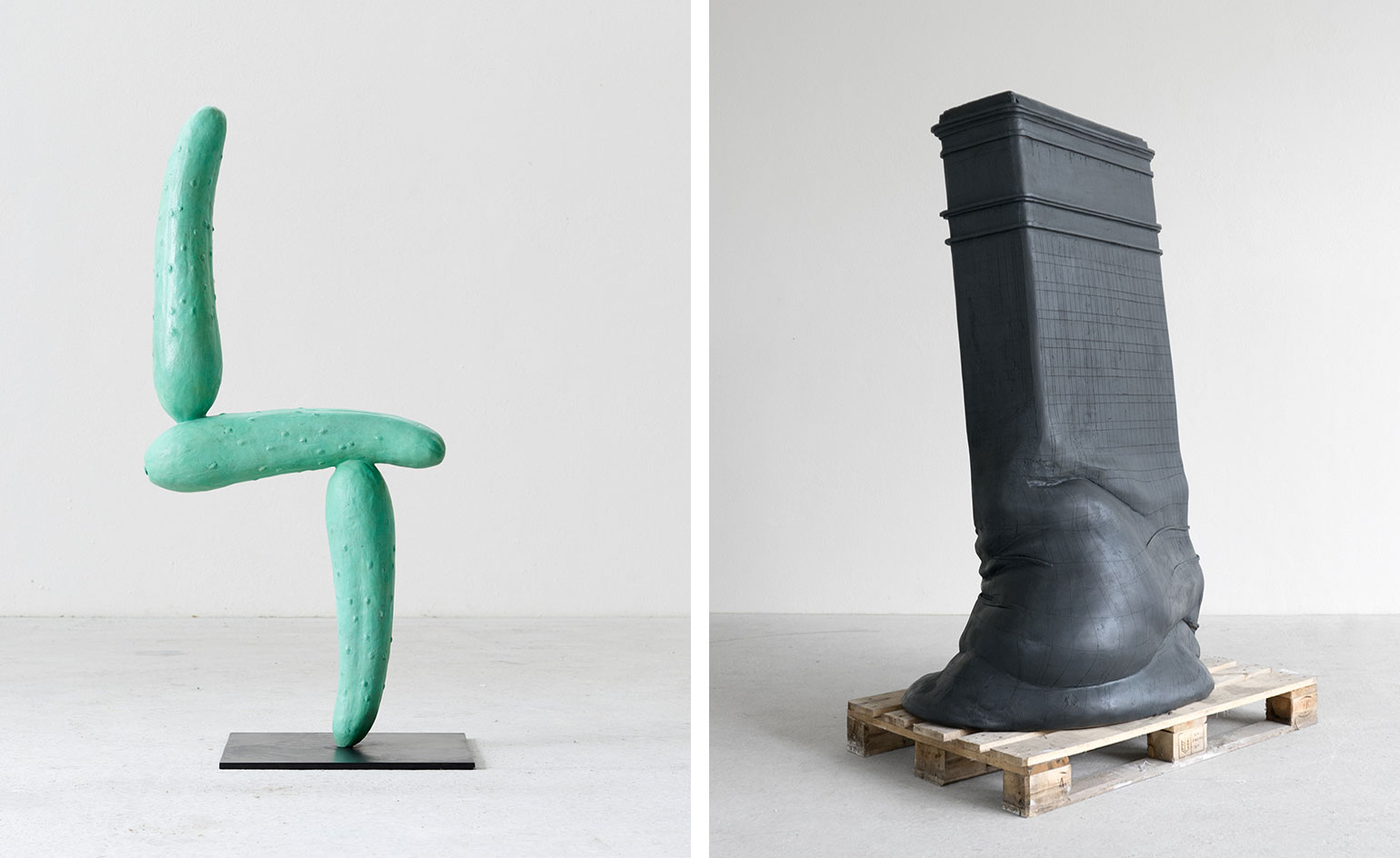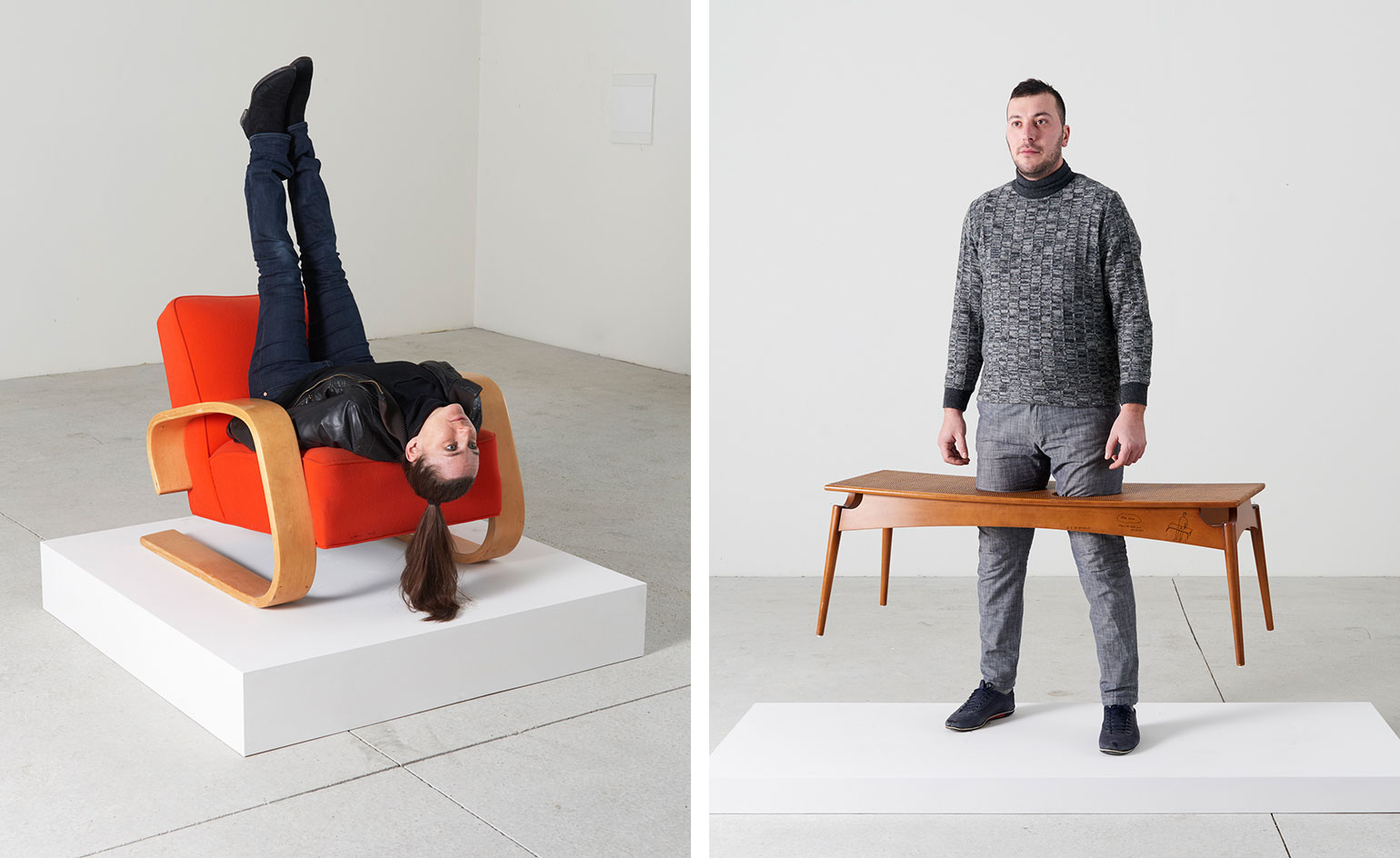Do you have a minute? Erwin Wurm debuts a new series of short-lived sculptures

In conjunction with the Austrian artist Erwin Wurm’s 20th anniversary of his one-minute sculptures - for which he is best known - New York’s Lehmann Maupin gallery is showing ’Ethics demonstrated in geometrical order’, displaying Wurm’s newest one-minute series and five new sculptures.
’The one-minute sculptures have changed a lot over the years since the first show I did in 1997,’ says Wurm. ’At first I tried playing around with the idea of sculptures who had a short existence, then it was me interacting with them, and later I thought it would be interesting to involve the public.’ The one-minute sculptures will also be presented at this year’s Venice Biennale.
The basic premise stays consistent. For each work, Wurm presents an object and creates a drawing and specific text inscribed on that object to instruct the user how to pose with it for one minute. The resulting awkward contortions are humorous, but the interaction contains deeper meanings. ’It’s related to issues of science, philosophy, psychology and explores ideas of free will and authorship,’ Wurm says. ’For a while, I used to make the drawing inviting the pubic to follow my instructions, then I would take a Polaroid photo and would offer to sign it for them, so it became an interplay of who was the author of the finished result. Then the iPhone came along and selfies happened and people were making one-minute sculptures on their own.’

'Organisation of Love', 2016, by Erwin Wurm as part of One Minute Sculptures
For this show, Wurm selected midcentury modern furnishings due to their current popularity. ’Furniture is something I’ve always found particularly intriguing because at the beginning everyone thinks something is unique, but then it becomes part of mass taste. People try to illustrate themselves and their lives through their furnishings,’ he explains. Throughout his work, Wurm plays with our common perception of how everyday items should be experienced, from household objects and furniture, to cars and buildings.
Wurm also presents partially melted sculptures of two New York landmarks, the Equitable building and the Flat Iron building in addition to seemingly random objects like a bag of clay and pickles. All of the sculptures distort the item, either by giving it an inflated, fat look, or as Wurm describes the melting process, ’double-destoys it.’ By changing the forms in these ways, Wurm believes he also changes the larger context and meaning of the object itself, even if that new meaning is unique to each viewer.

Left, Salatgurke Modernistisch, 2016. Right, Flat Iron, 2016

Left, Spaceship to Venus, 2016. Right, Deep Snow, 2016
INFORMATION
’Ethics demonstrated in geometrical order’ will be on view through 26 May. For more information, visit Lehmann Maupin’s website
Wallpaper* Newsletter
Receive our daily digest of inspiration, escapism and design stories from around the world direct to your inbox.
ADDRESS
536 West 22nd Street
New York, NY, 10011
Pei-Ru Keh is a former US Editor at Wallpaper*. Born and raised in Singapore, she has been a New Yorker since 2013. Pei-Ru held various titles at Wallpaper* between 2007 and 2023. She reports on design, tech, art, architecture, fashion, beauty and lifestyle happenings in the United States, both in print and digitally. Pei-Ru took a key role in championing diversity and representation within Wallpaper's content pillars, actively seeking out stories that reflect a wide range of perspectives. She lives in Brooklyn with her husband and two children, and is currently learning how to drive.
-
 Put these emerging artists on your radar
Put these emerging artists on your radarThis crop of six new talents is poised to shake up the art world. Get to know them now
By Tianna Williams
-
 Dining at Pyrá feels like a Mediterranean kiss on both cheeks
Dining at Pyrá feels like a Mediterranean kiss on both cheeksDesigned by House of Dré, this Lonsdale Road addition dishes up an enticing fusion of Greek and Spanish cooking
By Sofia de la Cruz
-
 Creased, crumpled: S/S 2025 menswear is about clothes that have ‘lived a life’
Creased, crumpled: S/S 2025 menswear is about clothes that have ‘lived a life’The S/S 2025 menswear collections see designers embrace the creased and the crumpled, conjuring a mood of laidback languor that ran through the season – captured here by photographer Steve Harnacke and stylist Nicola Neri for Wallpaper*
By Jack Moss
-
 The art of the textile label: how British mill-made cloth sold itself to Indian buyers
The art of the textile label: how British mill-made cloth sold itself to Indian buyersAn exhibition of Indo-British textile labels at the Museum of Art & Photography (MAP) in Bengaluru is a journey through colonial desire and the design of mass persuasion
By Aastha D
-
 Artist Qualeasha Wood explores the digital glitch to weave stories of the Black female experience
Artist Qualeasha Wood explores the digital glitch to weave stories of the Black female experienceIn ‘Malware’, her new London exhibition at Pippy Houldsworth Gallery, the American artist’s tapestries, tuftings and videos delve into the world of internet malfunction
By Hannah Silver
-
 Ed Atkins confronts death at Tate Britain
Ed Atkins confronts death at Tate BritainIn his new London exhibition, the artist prods at the limits of existence through digital and physical works, including a film starring Toby Jones
By Emily Steer
-
 Tom Wesselmann’s 'Up Close' and the anatomy of desire
Tom Wesselmann’s 'Up Close' and the anatomy of desireIn a new exhibition currently on show at Almine Rech in London, Tom Wesselmann challenges the limits of figurative painting
By Sam Moore
-
 A major Frida Kahlo exhibition is coming to the Tate Modern next year
A major Frida Kahlo exhibition is coming to the Tate Modern next yearTate’s 2026 programme includes 'Frida: The Making of an Icon', which will trace the professional and personal life of countercultural figurehead Frida Kahlo
By Anna Solomon
-
 A portrait of the artist: Sotheby’s puts Grayson Perry in the spotlight
A portrait of the artist: Sotheby’s puts Grayson Perry in the spotlightFor more than a decade, photographer Richard Ansett has made Grayson Perry his muse. Now Sotheby’s is staging a selling exhibition of their work
By Hannah Silver
-
 From counter-culture to Northern Soul, these photos chart an intimate history of working-class Britain
From counter-culture to Northern Soul, these photos chart an intimate history of working-class Britain‘After the End of History: British Working Class Photography 1989 – 2024’ is at Edinburgh gallery Stills
By Tianna Williams
-
 Celia Paul's colony of ghostly apparitions haunts Victoria Miro
Celia Paul's colony of ghostly apparitions haunts Victoria MiroEerie and elegiac new London exhibition ‘Celia Paul: Colony of Ghosts’ is on show at Victoria Miro until 17 April
By Hannah Hutchings-Georgiou